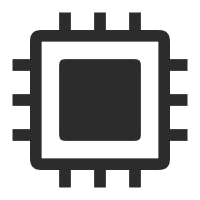In the field of professional computing and graphics processing, choosing the right graphics card is crucial.
NVIDIA's RTX A6000, based on the Ampere architecture, is a time-tested flagship workstation card, while the RTX PRO 5000 Blackwell, built on the latest Blackwell architecture, represents the new pinnacle of professional GPUs.
This article provides a comprehensive comparative review of these two graphics cards from a professional perspective.
1. Deep Dive into Architecture and Specifications
From an architectural generation standpoint, the RTX A6000 (Ampere architecture, 2020, 8nm) and the RTX PRO 5000 Blackwell (Blackwell architecture, March 2025, 5nm) belong to two distinct technological eras of NVIDIA's professional GPUs.
The former (GA102 core) features 10,752 CUDA cores, 84 RT cores, 336 Tensor cores, and 48GB GDDR6 memory (768GB/s bandwidth with ECC). The latter boasts 14,080 CUDA cores, 110 RT cores, 440 Tensor cores, and 48GB GDDR7 memory (1,344GB/s bandwidth, a 75% increase over the A6000).
From a specifications standpoint, the RTX PRO 5000 Blackwell shows significant improvements across the board, particularly in computational performance and memory bandwidth. However, architectural enhancements go beyond just core counts and clock speeds, introducing a series of revolutionary new technologies.
2. Comparison of Key Technical Features
RTX A6000's Key Technologies
As the professional flagship of the Ampere architecture, the RTX A6000 introduced several advanced technologies:
Second-Gen RT Cores: Doubled ray tracing performance compared to Turing, supporting real-time rendering of physically accurate shadows, reflections, and refractions.
Third-Gen Tensor Cores: Support for TF32/BFloat16 precision, doubling tensor performance and enhancing deep learning training/inference.
NVLink: Dual-card bridging with a total bandwidth of 112.5GB/s, expanding memory to 96GB for supercomputing tasks.
PCIe 4.0: Doubled bandwidth compared to PCIe 3.0, accelerating data-intensive tasks like AI and data science.
RTX PRO 5000 Blackwell's Key Technologies
The RTX PRO 5000 Blackwell, based on the Blackwell architecture, further pushes the boundaries of professional GPU technology:
Fourth-Gen RT Cores: Doubled performance, supporting RTX Mega Geometry with 100x more ray-traced triangles for hyper-realistic scenes and 3D design.
Fifth-Gen Tensor Cores: 3x performance boost, supporting FP4 and DLSS 4 multi-frame generation for faster local LLMs and new AI models.
MIG Technology: Supports two independent GPU instances (each with dedicated memory, cache, compute cores, and QoS), improving resource utilization.
PCIe 5.0: Doubled bandwidth over PCIe 4.0, accelerating CPU-GPU data transfers for AI, data science, and 3D modeling.
Next-Gen Codecs: Triple ninth-gen NVENC and sixth-gen NVDEC, supporting 4:2:2 H.264/HEVC encoding and improved HEVC/AV1 quality.
3. Performance Benchmark Comparison
Compute & Rendering Performance
SiSoftware Sandra tests show:
RTX A6000 video rendering performance varies by configuration, with single-precision shader performance around 9,882.72 Mpix/s.
RTX PRO 5000 Blackwell delivers 70 TFLOPS single-precision performance (80% higher than the A6000's 38.7 TFLOPS) and 211 TFLOPS ray tracing performance (2.8x higher than the A6000's 75.6 TFLOPS).
In AI workloads, Blackwell's Tensor cores achieve 2,223 TOPS (FP4), far surpassing the A6000's 309.7 TFLOPS, enabling efficient local large model and generative AI execution.
Real-World Application Performance
In different professional scenarios, the two GPUs exhibit distinct advantages:
Design Visualization: The A6000 excels with its 48GB memory for ultra-large 3D models, while the PRO 5000 Blackwell's fourth-gen RT cores and higher bandwidth enhance real-time rendering and complex geometry handling.
AI & Data Science: The A6000's 48GB GDDR6 supports most deep learning training, while the PRO 5000 Blackwell's fifth-gen Tensor cores and FP4 support accelerate inference/training (especially for generative AI and large models).
Media & Entertainment: The A6000 supports 8K editing, while the PRO 5000 Blackwell's ninth-gen NVENC encoding optimizes AV1/HEVC efficiency.
Scientific Computing: Both support ECC for data integrity, but the PRO 5000 Blackwell's PCIe 5.0 and higher bandwidth excel in CPU-GPU data-intensive tasks.
4. Power Efficiency & Cooling Design
Both GPUs have a 300W TDP, but their efficiency differs significantly.
The RTX A6000 uses a standard full-height, full-length dual-slot design (4.4" × 10.5") with a blower-style cooler for stable high-load performance.
The RTX PRO 5000 Blackwell, despite the same 300W TDP, leverages 5nm process technology and a more efficient architecture for superior performance-per-watt, making it ideal for multi-GPU compute clusters with lower total cost of ownership.
5. Use Cases & Recommendations
Based on the analysis, each GPU suits different scenarios:
Choose the RTX A6000 if:
Budget-conscious with large memory needs: Its 48GB GDDR6 handles most large datasets and complex 3D models at a potentially more affordable price.
Traditional rendering & compute tasks: For CUDA-heavy and rasterization-dependent workloads, the A6000 remains powerful.
Mature software ecosystem: With earlier release, its drivers and software compatibility are well-established.
Choose the RTX PRO 5000 Blackwell if:
AI/ML is a priority: Fifth-gen Tensor cores and FP4 support revolutionize local LLMs, generative AI, and deep learning.
Advanced ray tracing: Fourth-gen RT cores and DLSS 4 enhance real-time ray tracing for architecture visualization and virtual production.
Future-proofing: PCIe 5.0 and GDDR7 ensure readiness for upcoming tech demands.
Multi-user sharing: MIG technology allows GPU partitioning for improved resource utilization.
6. Conclusion
The NVIDIA RTX A6000 and RTX PRO 5000 Blackwell represent two peaks of professional GPU technology.
The A6000, based on mature Ampere architecture, excels in memory capacity and stability, ideal for traditional design/rendering tasks and budget-conscious users.
The PRO 5000 Blackwell, with revolutionary Blackwell architecture, dominates in AI, ray tracing, and efficiency, tailored for cutting-edge projects.
As Blackwell adoption grows, its advantages will expand, but the A6000 will remain competitive in its niche. Professionals should weigh performance, features, and cost to make the optimal choice for their needs.





















.png)
